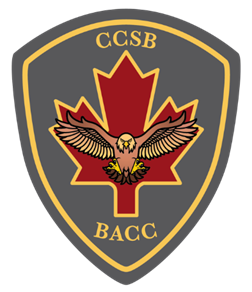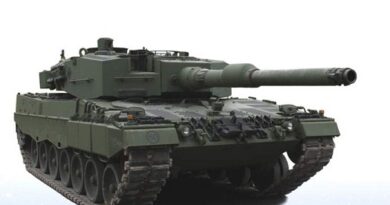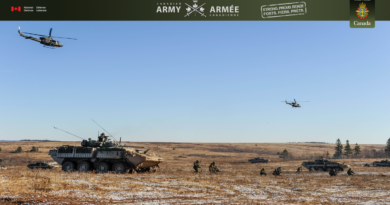The Canadian Combat Support Brigade
Note: This paper is based on a presentation made by Colonel LaFortune, Commander Canadian Combat Support Brigade, to RUSI(NS), 5 April 2019. Slides from the presentation are here.
The Canadian Combat Support Brigade (CCSB) is the newest brigade in the Canadian Army. It is unlike the other three brigades, the 1st, 2nd and 5th Canadian Mechanized Brigade Groups, in that it is not a brigade that will fight on its own or be involved as a brigade in operations. It is composed of units that will contribute to missions as necessary for a specific purpose.
The form of war has changed much due to changes in technology and the development of tactics that utilize those changes. It has evolved into what has been called in various countries grey wars, hybrid warfare and the Three Wars Concept. It is a level of conflict below major conflict, using non-violent means such as economic, legal and information warfare. It also uses ideas developed in our conflict in Afghanistan. In order to use these ideas and the special organizations involved, Canada has rapidly adapted. This adaptation ensures our soldiers are able to conduct operations safely in order to fulfill their mission as assigned by the Government of Canada through the military’s chain of command. This has meant the creation of new units or modification of existing units to meet these new types of organizations, equipment, changes to the nature of conflict and threat. Certain skills and capabilities are emphasized in each unit, such as Civil and Military Affairs (CIMIC), Psychological Operations (PSYOPS), intelligence, air space management, electronic warfare, target acquisition, and specialised engineering capabilities.
The proliferation of such units, all reporting to different Division headquarters, became problematic because of the span of control. Senior headquarters often had to deal with minor administrative actions inside a unit that were manpower, time and resource consuming. Lieutenant-General Steve Bowes, Commander of the Canadian Army Doctrine and Training Centre (CADTC) formed the Canadian Army Enabler Group in 2013-14. The group looked at models of two of our allies, Britain and Australia, to see best practices for developing a Canadian plan. The solution led to the establishment of the Canadian Combat Support Brigade (CCSB), stood up in 2016 as the fourth regular force brigade in the Canadian Armed Forces. The brigade became part of the 5th Canadian Division (5 Div) in October 2017. The units inside the brigade are known as enablers. (Definitions of a brigade, brigade group and other terms are found at the end of this paper.)
The brigade currently includes the following:
Canadian Combat Support Brigade Headquarters (CCSB HQ);
21 Electronic Warfare Regiment;
Canadian Army Intelligence Regiment;
4 Engineer Support Regiment;
4 Artillery Regiment (General Support); and
The Influence Activities Task Force.
The role of the brigade is to: “force generate combat support capabilities in order to enable Canadian Army and Canadian Armed Forces objectives across the full spectrum of operations.” (Full spectrum operations mean anything from general war to humanitarian operations anywhere in the world as decided by the Government of Canada through the Canadian Armed Forces chain of command.)
The brigade structure enables specialized units to concentrate on their areas of expertise rather than expending time and resources administering much of their training and movement, to meet operational and training requirements. It means this brigade will never be deployed on operations but stands as a force generator for other brigades or units. This means the brigade will become the centre of excellence for its unit’s capabilities and is responsible to the Commander of the Army to ensure the needs for each operation in these specialty areas are met. It also means that the brigade is responsible to ensure that any task is met and can be maintained and sustained for the length of the operation or training period.
The CCSB is an important and necessary organization. It is unique to the Regular Force Army in that it also includes a large Reserve component and employs civilians. Interestingly, it has elements of its organization across the country in the geographic area of every division of the Army. The brigade is ‘a work in progress’ not because of changes for change sake but to become more adaptable and flexible to meet the changing requirements of training and operations. The CCSB is itself an enabler to send the Canadian Army into the future. Below is an explanation of some key definitions. They have been simplified and are more general in nature than official doctrine.
Definitions:
Enabler – An enabler is an organization or capability that is specialized, for example the Canadian Army Intelligence Regiment’s specialty is intelligence operations. These capabilities are not found normally in a combat unit or the attachment is too small to perform duties on a fulltime basis based on normal manning in a normal garrison or training situation. For example, no Canadian Mechanized Brigade Group has an electronic warfare (EW) component, but in actual operations is essential for information gathering and protection. So when a unit is slated for overseas, it will receive a small portion of each of these capabilities from the CCSB. This slice of capability is provided for the specific mission only. The size of the slice will be determined by the nature of the mission and the threat the organization will face.
Brigade – a military organization composed of a small headquarters and two or more units. It has no support organization.
Brigade Group – a military organization composed of a headquarters, two or more units, and supporting arms. As an example, a brigade group can have a headquarters based on a headquarters and signal squadron, three infantry battalions (600 personnel each), an armour unit (400-600 personnel), supported by artillery, engineers, military police, and administrative support organization. The total manning is between 3000 and 4500 personnel depending on additional elements such as from the CCSB or air force aviation, e.g., helicopters.
Canadian Mechanized Brigade Group – as per the brigade group but equipped with a mixture of armoured and wheeled ‘soft skin’ vehicles.
Division – a major headquarters based on a signal regiment, with two or more brigades, with an artillery group composed of several artillery units, an engineer group with two or more combat engineer units and an engineer support unit, a divisional support group composed of several service battalions plus specialist support units for supply, maintenance and transport. It will have other organizations attached to it for specific operations. In Canada, a division is based on a geographical area, is made up of brigade groups and is established for training and force generation. It could be used as a basis for mobilization if so ordered.
Force Generation – this term means that the organization provides the manpower, training, equipment and resources to the organization that will employ those assets.
Force Employer – this refers to the organization that will actually employ those assets on a specific mission.
A PDF of this Information Note is available here.




